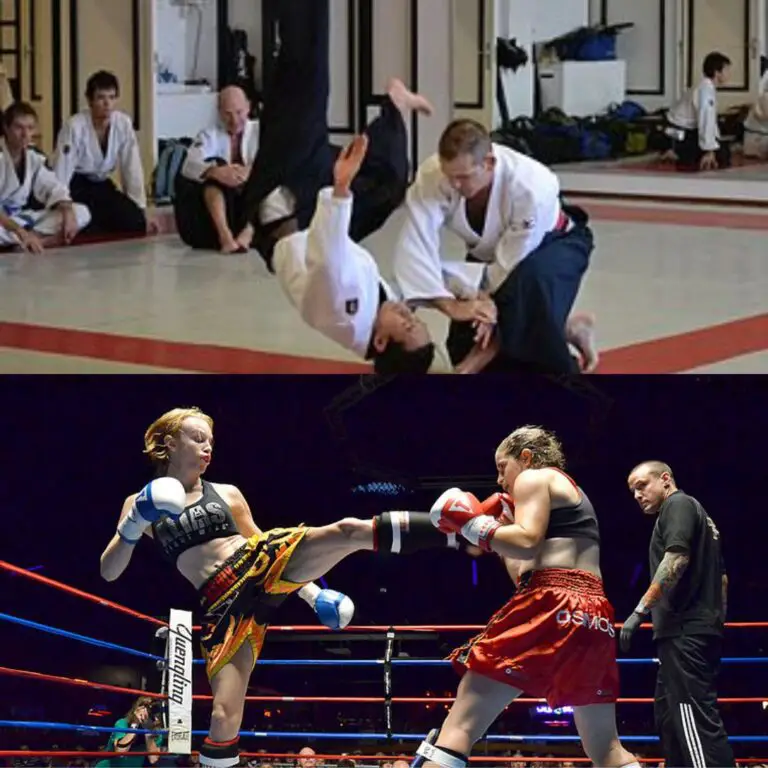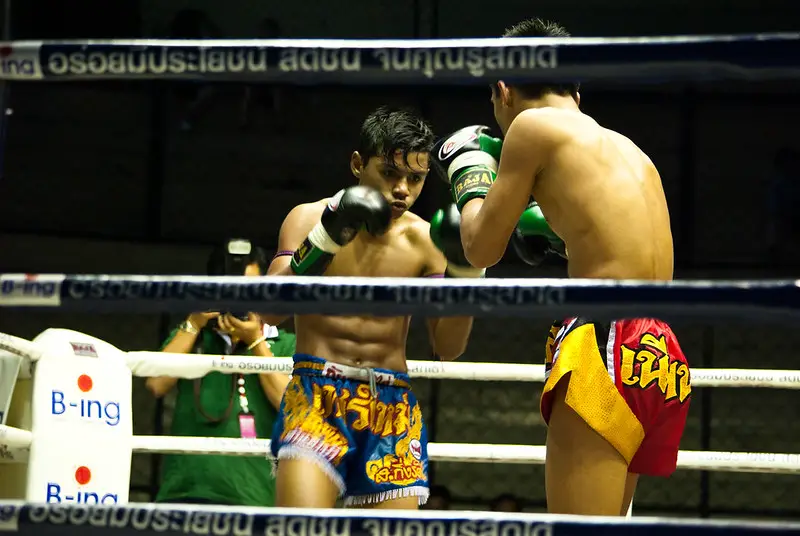Muay Thai vs. Aikido is one of the hottest topics within the martial arts community and this article aims to provide a comprehensive analysis of these two systems, and how they compare in different aspects.
As a full-contact system more oriented toward real fighting, Muay Thai is certainly more effective for self-defense, and its fighters are superior to Aikidokas in a one-on-one fight on the streets.
They have better skills, techniques at their disposal, instincts, and muscle memory needed for unpredictable and violent fighting.
But Aikido has unique advantages you are about to discover in this article and it certainly won’t go down without a fight.
What Is Aikido
Aikido is a Japanese martial art developed by Morihei Ueshiba. The system centres on the idea of harmonizing with an opponent’s energy rather than opposing it. The crucial principle is using the attacker’s momentum against them to protect yourself.
Aikido’s learning syllabus emphasizes circular movements and efficient use of body mechanics. Key techniques include throws, joint locks, wrist locks, and pins, executed in a focused manner and with high precision.
Distinctive to Aikido is the concept of “ai-ki,” meaning “joining energy,”. This is where the defender seeks to neutralize aggression by redirecting it fluidly and without using much energy and force.
What is Muay Thai
Also known as the art of “Art of Eight Limbs,” Muay Thai is a dynamic and traditional martial art originating from Thailand. Known for its emphasis on powerful strikes and clinch work, the concept includes an all-around skill set that utilizes:
- Punches
- Kicks
- Elbows
- Knee strikes
- Clinch Fighting
It is widely regarded as the most complete striking system because it covers all the ranges, including the clinch where fighters can also execute grappling techniques such as trips and throws. However, ground fighting or striking the grounded opponent is not allowed.
The emphasis is on full-contact striking, damage, and causing injuries which makes it one of the hardest combat sports. Training is hard, and realistic, includes a lot of sparring, grueling cardio, and strength workouts, and will teach you all about the physical and mental aspects of real combat.
Muay Thai or Aikido For Self-Defense?
Muay Thai is more effective for real-world fighting, and its skills and techniques are more practical in self-defense situations. Though some Aikido principles might work, the system lacks any type of realistic methods of teaching such as sparring. Or, techniques and skills that can be applied in a real fight.
Here is a detailed explanation:
Muay Thai training program is more realistic
Muay Thai’s training program is widely regarded as more realistic compared to Aikido. Practitioners engage in regular sparring sessions, which simulate real-life combat scenarios, allowing them to develop practical skills under realistic pressure.
In contrast, Aikido training often lacks intensity and realism. It focuses on choreographed movements and pre-arranged attacks and simulations. This limits its application in real-world scenarios and overall effectiveness.
Muay Thai techniques are more practical than Aikido
Thai boxing teaches only the battle-tested techniques that are practical and work well in freestyle combat. The emphasis is on powerful strikes and clinch work, providing efficient tools for dealing with physical threats. Practitioners learn how to throw each shot with power and goal to cause injuries and hurt the attacker. This makes Muay Thai highly effective in different self-defense situations, more than Aikido.

Aikido’s emphasis on redirecting an opponent’s force does not work well in real life. At first glance, it may visually look impressive. But in reality, these techniques work only in pre-arranged attacks and controlled environments.
These are not as effective in unpredictable scenarios you may face on the streets.
Thai boxers are tougher and physically and mentally better prepared
Moreover, Thai boxers are known for their toughness, both physically and mentally. The demanding training regimens build mental resilience and endurance, preparing practitioners to face adversity with a calm mind and proper skills. Compared with Aikido students, they are better trained to absorb hard shots, and not to panic when they are hurt.
Muay Thai vs. Aikido — Who Would Win In a Fight?
The advantage generally lies with the Muay Thai fighter due to the practicality and effectiveness of its techniques in real-world combat scenarios. The emphasis on powerful strikes, clinch work, and realistic sparring prepares fighters for the unpredictability of a fight, making them better equipped to handle various situations.
In contrast, Aikido’s emphasis on redirecting an opponent’s force through joint locks and throws may be less effective. These techniques are almost impossible to apply in unchoreographed fights where immediate actions are crucial. Due to the lack of spontaneous sparring and other aspects of realistic training, they are not prepared to apply these skills in a real fight.

For example, they are not physically and mentally trained to absorb hard punches and kicks. Their minds and bodies are not prepared for the brutality and unpredictability that come with real fighting, and that’s why they would lose most of the time.
Thai boxers are capable of generating force in a kick similar to hitting someone with a baseball bat. Imagine Aikidoka, who never trained to absorb kicks or punches, receiving such a strike to the leg, body, or in the worst-case scenario, straight to the head.
Thai boxers simply have much better muscle memory, instincts for fighting, and far more effective techniques at their disposal. And, they would win the fight against Aikidoka probably 9 out of 10 times, if not more.
Muay Thai vs Aikido- which one is better for MMA?
Muay Thai is better for MMA because it fits well within the rules of the sport, and its techniques are more practical and effective. It is widely regarded as the best striking martial art for MMA because it includes full-contact striking using all limbs, and covers all the ranges, including the clinch.
Further, cage fighting requires a level of athleticism, durability, mental toughness, and muscle memory. Thai boxing meets all the criteria due to its heavy emphasis on hard sparring, gruelling cardio, strength workouts, competition, and winning matches so they are more likely to switch over to MMA and succeed than Aikidokas.
It is also more adaptable, allowing fighters to combine striking techniques with grappling and ground fighting to develop an around game.
Is Aikido Used in MMA?
Aikido is not commonly utilized in MMA due to several reasons. Its focus on joint locks, throws, and redirection of force, while philosophically rich, may lack the immediate and impactful nature required in the fast-paced environment of MMA.
The absence of competitive sparring in traditional Aikido is the direct cause. It can result in a gap between its theoretical principles and practical application. And as far as its effectiveness is concerned in cage fighting, this is a big problem. It is the main reason why you won’t see Aikidokas coming to MMA and relying on their skills to win matches.
Muay Thai vs Aikido —Which One Is Harder To Learn?
Both Muay Thai and Aikido present unique challenges in their learning curves. Understanding the difficulty of each requires considering various factors:
Why Muay Thai is hard to learn:
- Physical Demands. Muay Thai places a significant emphasis on conditioning, requiring practitioners to develop strength, endurance, and flexibility. The physical demands of executing powerful strikes and intense training sessions can be strenuous, especially for beginners.
- Complex Techniques: Learning the diverse set of striking techniques, clinch work, and defensive manoeuvres in Muay Thai demands time and repetition. The coordination of kicks, punches, elbows, and knee strikes, along with effective defensive strategies, adds complexity to the learning process.
- Sparring and Realistic Training: Regular sparring is a crucial component of Muay Thai training, providing practical experience. However, adapting to the unpredictable nature of sparring and the physical intensity it entails can be challenging, particularly for beginners.
Why Aikido is Hard to learn:
- Unorthodox Movements: Aikido techniques often involve circular and unorthodox movements, requiring practitioners to develop a level of body awareness and flexibility. Executing precise joint locks and throws demands mastering nuanced movements and timing.
- Philosophical Understanding: Aikido places a strong emphasis on philosophical principles such as harmony and non-resistance. Understanding and embodying these concepts in practice can be challenging for those unfamiliar with martial arts philosophy.
- Limited Realistic Training: Aikido’s training often involves pre-arranged movements and cooperative partners, limiting exposure to the realistic scenarios encountered in dynamic, unscripted situations.
What Is The Difference Between Aikido and Muay Thai?
The key difference is the concept as Thai boxing is a full-contact sport that emphasizes damage while Aikido is a martial art rooted in tradition and philosophy, focused more on personal growth.
History
The difference between Aikido and Muay Thai spans various aspects, starting with their historical origins. Aikido, developed by Morihei Ueshiba in the early 20th century, draws from Japanese martial traditions.
On the other hand, Muay Thai originates from Thailand. Its origins come from the military system “Muay Boran”, and it emerged as a sport in the 19th century.
Techniques
In terms of concept and technique, Aikido revolves around the principle of harmonizing with an opponent’s energy, employing joint locks and throws.
In contrast, Muay Thai emphasizes powerful striking techniques using punches, kicks, elbows, and knees, along with clinch work and limited grappling techniques.
Realism
Teaching methods distinguish the two further. Muay Thai often employs realistic training through sparring sessions, simulating actual combat scenarios. Aikido, on the other hand, frequently involves pre-arranged movements and cooperative training, limiting the practical application of techniques in dynamic situations.
Concept and Philosophy
While Muay Thai has evolved into a popular combat sport, emphasizing competition and physical prowess, Aikido remains rooted in philosophical principles, viewing itself as a martial art more than a sport. In fact, there is no sport variation of Aikido.
This contrast extends to their overall effectiveness, with Muay Thai recognized for its practicality in self-defense and competitive settings, while Aikido’s effectiveness may be more subjective, dependent on the practitioner’s interpretation and application of its principles.
Is Aikido a Good Complement To Muay Thai?
Combining Aikido with Muay Thai can offer a well-rounded and complementary approach to martial arts training. Combining wrist locks, rolls, and throws from Aikido with full-contact striking from Thai boxing can enhance your overall game and chances of winning a fight. In some way, it will add new dynamic to your overall skills.
Which one is going to be your priority depends on individual preference and other related factors.
While Muay Thai excels in striking and clinch work, Aikido introduces principles of balance, timing, and fluidity that can enhance a fighter’s overall adaptability. This is notably true when it comes to wrist control, joint locks, throws, and falls.
The fluid movements and principles of Aikido can aid in evading attacks and creating openings for counters, complementing the direct and powerful techniques of Muay Thai.
The integration of Aikido and Muay Thai can lead to a more versatile martial artist, capable of adapting to a range of situations. Overall, the combination of these two martial arts can provide practitioners with a holistic skill set, blending the strengths of Muay Thai’s aggression and power with Aikido’s finesse and adaptability.
Aikido vs Muay Thai — Which One is Better?
Muay Thai emerges as the superior choice. Its emphasis on powerful strikes, clinch work, and realistic training makes it highly applicable for self-defense, where immediate and impactful responses are crucial.
This is notably true if you look at how it aligns with the demands of MMA, providing a versatile skill set that transitions well between striking and grappling in the cage or ring.
On the other hand, Aikido brings its own unique advantages. Its emphasis on joint locks and throws can be useful in controlled environments, offering an alternative approach to martial arts practice that may appeal to those seeking a more philosophical or meditative experience.
Ultimately, the choice between Aikido and Muay Thai depends on individual goals and preferences. While Muay Thai excels in practical self-defense, MMA, and real fighting scenarios, Aikido offers a distinct set of principles and techniques that may resonate with those seeking a more contemplative martial arts experience.


